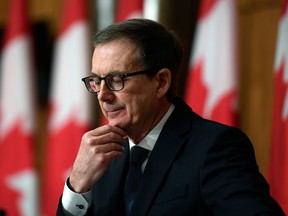In an interview with Kevin Carmichael, Macklem talks about the central bank’s fight against inflation
Article content
Financial Post editor-in-chief Kevin Carmichael sat down with Bank of Canada governor Tiff Macklem on Dec. 19, days after the central bank announced its decision to raise interest rates another 50 basis points, bringing the benchmark borrowing rate to 4.25 per cent. What follows is an edited transcript of their conversation.
Advertisement 2
Article content
Kevin Carmichael: One personal question. I was reading about Paul Volcker over the weekend and was reminded that the U.S. construction industry took to mailing him chunks of two-by-four (lumber) that they weren’t selling because of what he did to the U.S. economy to get inflation under control. What’s the most creative expression of frustration that Canadians have sent you?
Article content
Article content
Tiff Macklem: I read my correspondence regularly and it’s a pretty good thermometer of how Canadians are feeling. You can really see what’s foremost on Canadians’ minds.
A year ago, a lot of the letters were from couples who were trying to buy a house and would put offers in on multiple houses. Haven’t succeeded. They were really frustrated. Now, the letters are about inflation and about higher interest rates.
Advertisement 3
Article content
There’s no question. Canadians are feeling the pain of inflation. It’s been a long time since inflation has been this high. There’s a whole generation that’s never felt this kind of inflation. And, particularly for people who did buy houses at the top of the cycle, with a variable-rate mortgage, there’s feeling real financial strain. You do feel for these people.
There’s no question. Canadians are feeling the pain of inflation
Tiff Macklem
KC: Do you make a point to read these letters yourself every week? What’s your approach?
TM: I do read them myself. I do have some help responding to them, but I read the responses and I edit almost every letter. I often do it on Friday afternoons.
KC: Do you have a certain number you try to read in a week? You’ve got a lot to do.
TM: As many as i can, but no, I don’t have a target.
Advertisement 4
Article content
Canada’s biggest vulnerability
KC: You mentioned that you are getting questions about variable-rate mortgages. I’ll use that to jump to a debt question. We’ve talked about a reckoning for the last decade, decade-and-a-half, given how much household debt and corporate debt has run up during that period of low interest rates. To what extent is debt weighing on your ability to confront inflation?
TM: Higher levels of household indebtedness are a vulnerability for the Canadian economy. We’ve been highlighting that for a long time.
There’s no question that household indebtedness is high. It’s not evenly distributed. Many households through the pandemic ended up saving money because they weren’t spending it on vacations or going out to restaurants. They saved that money. But, also, many Canadians were stuck at home. They wanted more space. We were all working at home. The kids were probably going to school at home. Recreation was all at home. People were looking for more space. Interest rates were very low, so many people took on more debt and bought a bigger house.
Advertisement 5
Article content

One of the implications of that is with more household indebtedness, when interest rates go up, the cost of servicing that debt goes up, and the bigger the debt, the bigger the service cost. Other things equal, it means monetary policy can have more of an effect — it can work faster. We’re certainly seeing rapid slowing of the housing market.
As I said, the other side of that is that some Canadians actually saved some extra money. So some Canadians have a buffer. We’re certainly looking closely to see if monetary policy is working faster, if it’s getting more traction and that’s something we’ll need to factor into what we need to do to get inflation back down.
KC: Can you elaborate on what you’re looking at to see if policy is getting more traction than if there wasn’t so much debt?
Advertisement 6
Article content
TM: If you have estimates of the response of housing to interest rates, it’s not out of line with history. That’s one thing you look at; when I say aggregate models, you look at the housing market in aggregate.
The other thing … there are large datasets, with a large number of mortgages (they are all anonymized of course), but we have large datasets looking at mortgages, looking at credit card data. And those allow you to see how interest rates are affecting Canadians in different situations. So, you can get a better measure of how many Canadians have a variable-rate mortgage and how many have a fixed-rate mortgage, and when are those going to get renewed?
So, you can get a sense of how higher interest rates, how quickly or how slowly it will feed through and then what the cost of that is going to be. That’ll help you in getting an assessment of what the impact is going to be on their spending behaviour.
Advertisement 7
Article content
You try to use these aggregate models with this more micro data and draw the links between them. They don’t always match up perfectly. That’s part of the challenge. But when it does fit together, you get a better handle.
KC: What do you make of the elevated savings rates, at least relative to what we’ve gotten used to over the last decade or so? Are they providing a buffer that might cushion the effects that those who most worry about indebtedness assume will be the ultimate outcome of those burdens?
TM: The savings rate went way up during the pandemic. It has come a long way back down, but it’s still above pre-pandemic levels.
As I said, it’s not evenly distributed. Not everybody has extra savings. The individuals in the bottom quartile of income have the least amount of extra savings. They are more vulnerable, and for them, high inflation has really eroded those savings.
Advertisement 8
Article content
So, It’s not evenly distributed, but certainly for some Canadians it is providing somewhat of a buffer. Then you have to weigh that against how households in general are fairly highly indebted in Canada.

KC: Last question on debt. What kind of fiscal policy would help the country get through this inflationary episode? What should, or what could, fiscal policymakers be thinking about as they prepare their budgets for next year?
TM: I’m very cautious about giving fiscal advice. Monetary policy is a big enough job.
Governments, they have a lot of priorities and they’ve got to make difficult decisions. We’ll take those and we’ll build those into our outlook. Look, Canadians are feeling the pain from inflation and their elected representatives are acutely aware of that. And there, I think the advice from the (International Monetary Fund) is good advice. That advice is to, where governments are considering measures to protect people from inflation, target those measures on the most vulnerable. They’re the ones that are feeling the most pain from inflation. They are the least able to absorb higher prices.
Advertisement 9
Article content
And make these measures temporary. If governments heed that advice, then monetary and fiscal policy won’t be in conflict.
KC: My reading of what went on in the 80s is that monetary policy and fiscal policy were in conflict. Is that also your reading?
TM: In the later part of the 80s? Yeah, I think there is some truth to that. It certainly made things more difficult than it had to be.
Two per cent or bust
KC: In the spirit of transparency, I wondered if you could talk generally about when you would be satisfied that inflation is back to where you want it to be. Do you need to see it get all the way to two per cent to be comfortable that you’ve crushed inflation? Or would you be comfortable as soon as it enters the one- to three-per-cent band? Would that send a signal that we have this under control?
Advertisement 10
Article content
TM: I think comfort is on a continuum and right now we’re highly uncomfortable. Inflation is way too high. Headline has come down a bit and that is some relief. Just the fact that it stopped going up, and has come down a little bit, is a bit of relief.
Underlying inflation, core inflation, it’s around five, a little over five, and it has not meaningfully come down. You can see some early green shoots, if you look at three-month moving averages. If those keep coming down and are sustained, core should come down.

Our projection is core is probably going to remain uncomfortably high for the next few months. But when we get to the spring, the snow melts, we expect to see the cumulative effects of our higher interest rates will really be starting to work and you should at least start to see core moving lower. If we really start to see that, that’ll be certainly comforting. But we are acutely aware that our target is two per cent and we’re a long way from two. We’re not going to sleep easy until price stability is restored and that’s two-per-cent inflation.
Advertisement 11
Article content
KC: So it’s really two per cent? I think there’s been some confusion over the years about what exactly the Bank of Canada sees as the target. Yes, the midpoint, but the previous governor reminded us that there’s a range, and anything in the range could be acceptable.
TM: The target is two per cent. The range is really to give you an idea of what is kind of a normal variation. It doesn’t mean you’re not going to be outside the range from time to time, but you should be in the range more than half the time. But if you want to be in the range more than half the time, you need to aim for the middle of the range.
Lessons learned
KC: Let’s go back to your year-end speech now. You laid out some lessons from failing to anticipate the surge in inflation. How do you intend to apply those lessons?
Advertisement 12
Article content
TM: I laid out three lessons. The first is, it’s harder to restore supply than demand. The second is, when you focus on the aggregate, or the averages, you can miss some inflationary pressures. And the third was, when the economy is in excess demand, supply shocks, negative supply shocks, supply disturbances, have a bigger effect on inflation.
So, how are we taking those to heart? Three ways.
The first is, if you want to look at the economy more granularly, if you want to disaggregate, you need to look at some different types of data, you need some different types of decision-useful assessments. I’ll give you a few examples. During the pandemic, we started using a whole range of non-traditional indicators, things like mobility indices, restaurant bookings, to try to gauge whether behaviour was getting back to normal, whether people being more cautious? How are people responding? Those were very useful in getting a sense of how quickly or how slowly people were getting back to more normal activities.
Advertisement 13
Article content
We have been very surprised by the persistence, and the pervasive nature of supply shocks. These global supply networks, supply chains, they’re real marvels of logistics and system design, transportation, and as long as they work, we just take them for granted. But we’ve discovered they’re very tightly coupled, they’re complicated, and when one thing goes wrong the whole thing gets gummed up. So, we’ve invested in putting together a heat map of a whole range of supply chain indicators and they’re colour coded, so you can look at them individually, but can also get kind of a visual impact of the total effect. They were mostly red and then they’ve gone to yellow. Some are still yellow, some are green now. We have seen improvements there.
Advertisement 14
Article content

We’ve been looking at a wider array of labour market indicators. We report those on our website. We’ve also got more disaggregated data on credit card spending and mortgages, and that’s been useful. So that’s sort of bucket No. 1.
Bucket No. 2 is we are looking at enriching our models. If you want to understand how a supply problem on the other side of the world impacts Canada, what you can do is you can use the input/output structure of the Canadian economy and build a model that shows that if this input from this side of the world doesn’t come to Canada, what does that affect in Canada?
Another example … one of the things we saw when inflation went up to seven, eight per cent, not only were companies increasing their prices by more, but they were changing their prices more frequently. What that meant was the pass-through of higher input prices — higher energy prices, higher shipping costs, higher agricultural prices — was coming much faster than it had historically. In a lot of our models, we have a fixed interval where businesses change prices. Now, we need to enrich those models and allow that when inflation goes up a lot, firms may not only change how much they change prices, but also the frequency. This time last year, inflation was about four and a half per cent. And at four and a half per cent, businesses were not changing the frequency. It was really as we got through the late spring and the summer, and inflation was seven/eight per cent, that’s where you saw the frequency of price changes go up.
Advertisement 15
Article content
In the whole period that we’ve had an inflation targeting, yes, we’ve had fluctuations of inflation, but inflation has never gotten up to seven/eight per cent. The previous highs were more like five per cent. It stayed in this kind of more normal zone where assuming it was constant was a reasonable approximation. But what we’ve rediscovered is that when inflation is seven/eight per cent, that’s not a reasonable proximation. So, we need to enrich our models.

The last thing I would say is that we’ve been working on being better listeners and better communicators. On the listening front, now that pandemic restrictions are lifted, we can travel across the country. I was in Vancouver last week. It’s an opportunity not only to speak to a live audience, but it’s also an opportunity to visit businesses and to find out more about what’s going on locally. What are foremost in people’s minds?
Advertisement 16
Article content
More formally, we’ve had the Business Outlook Survey, which has been very valuable, particularly through the pandemic. That’s an in-person, once a quarter, structured interview. The advantage of it is, we have a long-time series now, 20 years. We’ve supplemented that with something called the Business Pulse Survey, which is a digital online survey that gives us very good reach, particularly into small- and medium-sized businesses. We don’t have a long-time series, so you’ve got to be a little bit careful in interpreting it, but you can be more nimble, you can try different questions, you can be a bit more topical. That has proved quite helpful, and you’ve seen us start to talk about that in some of our reports.
Broken models
Advertisement 17
Article content
KC: Economic models led to a misinterpretation of what was happening ahead of the Great Recession. You mentioned your models gave you a head fake, if not worse, this time around. Has the way we go about policymaking become too reliant on mathematical modelling? Is one of the lessons to take a step back and try to do a little less?
TM: Models definitely have limitations, particularly when you’re dealing with something that is unprecedented like a pandemic. Your models are going to have even more limitations than normal. Models, by construction, reflect the average of history. So, if something happens that isn’t in history, your estimated model is not going to do a very good job of capturing it.
I don’t think you can say, though, that if we hadn’t had models, we would have had a better response. There were some fundamental uncertainties. Our models still help us. You definitely have to recognize what are the limitations of any model. You also want to use more than one model … And then you’ve got to supplement that with other information. Make it real. Talk to businesses. Our Business Outlook Survey, our Business Pulse Survey have been very helpful in that regard.
Advertisement 18
Article content
At the end of the day, there’s a lot of judgment. You’ve got to weigh the evidence. You’ve got to think about the risks. What if we’re wrong about this? What if we’re wrong about that? So yes, we need to improve our models, but I don’t think, at least for the foreseeable future, I don’t think monetary policy is ever going to be a model-based exercise where you can just feed it all into a model and your answer is going to come out.
You also have to remember that, fundamentally, economics is about studying people’s behaviour. And, people are also going to react in different ways to things that haven’t happened before.
Inflation ‘messes up’ competition
KC: This is a jump cut, but I want to get to a couple questions before we run out of time. You’ve said that you observed that companies passed through higher commodity prices on the way up and you’re going to be watching to see what happens on the way back down. What did you mean by that?
Advertisement 19
Article content
TM: I actually mean two things by that. The first is that one of the things we’ve seen through this recent period of high inflation is that it’s been a reminder, an unpleasant reminder, of just how much inflation messes up the competitive system.
What we’ve seen is that, when energy prices have gone up, commodity prices have gone up, companies have passed through these higher input prices very quickly to the final goods prices. That’s one of the reasons why inflation has gone up so rapidly. And why is that? Businesses were faced with more demand from their customers than they could supply. So, they weren’t terribly worried that if, well, if we raise our prices, we’re going to lose a few customers. They couldn’t meet all the demand that they faced. So, they passed it through very rapidly. It’s a reminder that when the economy is in excess demand, price shocks to commodity prices can have a bigger and more rapid effect.
Advertisement 20
Article content
When I say, “We’re going to be watching that,” one of the things we mean by that is, we want to restore this competitive system. We want companies to be worried that if they raise their prices, they’re going to lose customers. We want households to not accept higher prices and to shop around. But when inflation is seven/eight per cent and it’s very broad based, you can’t blame households when they say, “I just have to pay these prices, everything’s going up.” Once inflation starts to come down, we certainly want to see that competitive process restored, so that businesses are thinking twice about raising their prices.
We want companies to be worried that if they raise their prices, they’re going to lose customers
Tiff Macklem
And then the other thing we mean by that is yes, we’ve seen inflation go up rapidly, we’ve seen businesses pass through higher input costs quite quickly to final goods prices. We’re now seeing some of those input prices roll over. Oil prices have come down considerably. Shipping costs are coming down. Agricultural products, their prices are still high, but they have come down off their peak. We saw companies protect their margins and pass those higher prices on quickly to final goods prices. Yes, we expect to see companies pass the lower input prices through just as quickly.
Advertisement 21
Article content
KC: Were you surprised by the rapidity of the pass-through? Ahead of the crisis, there was an argument that bigger companies in highly concentrated industries would use their market power to absorb some of the inflation to retain market share, or even win market share.
TM: We’re not the competition authority. I’m going to leave competition policy to the government and competition assessments to the Competition Bureau.
What we saw was it had a lot to do with the economy being overheated. A year ago, inflation was about four and a half per cent. Unemployment was about a percentage point higher than it is now. We were all changing our Christmas plans because Omicron was hitting. Services (inflation, excluding shelter) was running around two per cent. And even putting in shelter, it still was reasonably low. Inflation was not broad-based. And in that, period, we did not see the frequency of price changes increasing, even though inflation was well above our target. It was not until you get more into the spring and the summer where you started to see behaviour changing.
Advertisement 22
Article content
The economy reopened rapidly and never looked back. There wasn’t another wave. And households were eager to quickly catch up on those in-person services they had not been able to enjoy for two years. Companies simply couldn’t keep up. They could not keep up with the demand. We saw that put a lot of pressure on prices. Prices went up quickly.
Great demographic reversal
KC: We’ve had a great reversal of a series of disinflationary forces that are now inflationary. Given that, why should Canadians have confidence that a monetary policy regime that was put in place during a very different time is still suitable for the current environment?
TM: I’d say two things. First of all, there is no long-run trade-off between output and inflation. If inflation is high, Canadians have to continue to deal with the anxiety and the hardship of inflation every year.
Advertisement 23
Article content
-

Tiff Macklem says he won’t settle for anything less than a return to 2% inflation
-

Sticky inflation numbers probably not to Bank of Canada’s liking
-

Kevin Carmichael: The failure at the Bank of Canada that likely made inflation worse
-

Canadians have lost $500 billion in paper wealth, but there’s a silver lining
Coming back to the two per cent target. Why two per cent? We’ve done multiple reviews about the inflation target. The target has been two per cent since 1995 and roughly every five years we’ve had a thorough review. We’ve considered a lower target. We’ve considered a higher target. And for a whole variety of technical reasons, two continues to look like a good target.
But I think the most basic reason is that at two per cent inflation, inflation is low enough that Canadians don’t need to worry about it. Yes, the price level is drifting up, but it’s drifting up gradually enough that it doesn’t matter to the lives of most people year to year. They can be pretty confident that the cost of living is not going to change very much. And obviously, we’re not going to hit two per cent every year. But most of the time, it should be somewhere between one and three. And so from one year to the next, Canadians are not going to see a big, big change in their cost of living. That’s one less thing for them to worry about. They can get on with the decisions they need to take in their lives. Low inflation is a public good.
Yes, there are some big forces that are going to be affecting our economy (and) other economies in the years ahead, and we’ll have to factor those in and adjust to them. But it doesn’t seem to me how giving up on two-per-cent inflation is going to help. If we don’t have price stability, all those things just get more complicated.
• Email: kcarmichael@postmedia.com | Twitter: CarmichaelKevin
Advertisement
Tiff Macklem on debt, lessons learned, why inflation hurts competition
2022-12-23 22:12:03






